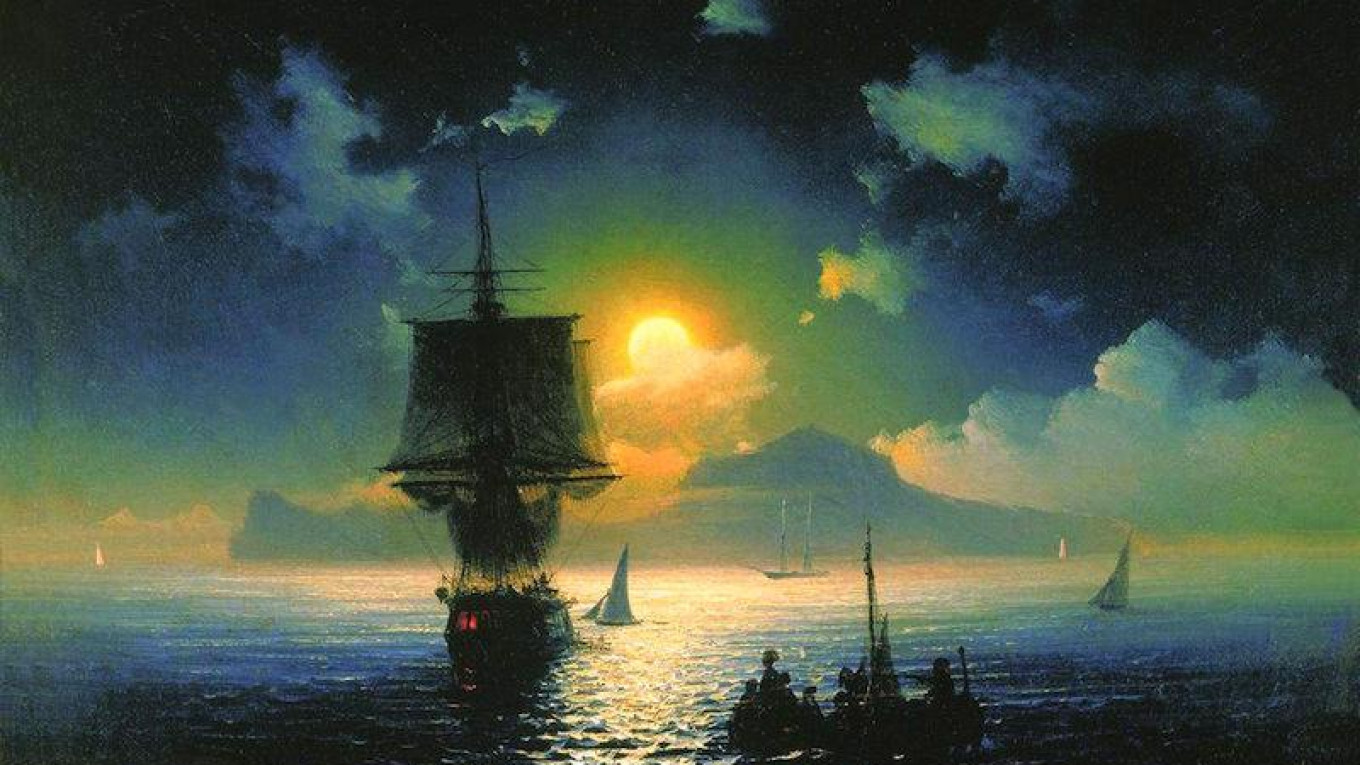The show of the summer has arrived. Moscow's New Tretyakov Gallery has gathered together 150 works by Ivan Aivazovsky, Russia’s most famous and beloved painter of seascapes, in a wide-scale exhibition to celebrate the 200th anniversary of the artist's birth. The capital may be landlocked and stuffy, but marveling at the limitless horizons, crashing waves, and raging tempests Aivazovsky so masterfully recreated, you can practically feel a cool sea breeze in the air.
A Master
Aivazovsky was a prolific painter. Born into an Armenian family in the Black Sea Port of Feodosia in 1817, he achieved critical acclaim during his lifetime and completed over 6,000 artworks before his death in 1900.
Whittling down the exhibited paintings from the thousands was unsurprisingly no easy task for the organizers: “It involved many hours of discussion about how we want to showcase the painter and what we want to disclose about him, to reveal,” said Zelfira Tregulova, director of the Tretyakov Gallery, in an interview with The Moscow Times.
Since the painter is one of the country’s most popular artists, the Tretyakov managed to presell 20,000 e-tickets before the exhibition's doors had even opened to the public. This figure is hardly surprising when you remember that Chekhov's phrase "a sight worthy of Aivazovsky's brush" became popularized as the way of describing something “ineffably lovely.”
The exhibition is not chronological, but rather laid out according to themes such as “Sea Symphonies,” “The World at Large Was Much Too Small For Him,” and “But Day is Fading — Night Had Come” to outline the artist’s dimensions. Changing preconceptions about Aivazovsky — that he did more than paint the ocean — was the main aim of the Tretyakov's curators.
Along with the oil paintings, 55 etchings and marine objects including some of the painter’s personal belongings occupy the second floor of the show. After admiring the grandeur of his artwork, the selection of model ships, telescopes, and other jumble is little underwhelming, but it does provide some interesting context, anchoring the painter in the infinite seascapes he created.
A Voyager
Aivazovsky traveled the oceans, often aboard military ships as the main painter of the Russian navy, and was almost killed by a fierce storm in the Bay of Biscay. He was both a romanticist and realist: he had experienced the ocean’s savagery and man’s futile struggle on its surface, but also its salvation. Perhaps this is why many of his works radiate light through ominous skies.
Of the paintings on show, “The Ninth Wave” is his best known. The giant canvas is a fusion of hope and desperation, the fraught faces of the stranded sailors warmed by a hopeful sunrise.
And his paintings reflect these travels. The Imperial Academy of Arts sent him to study in Europe and he collected accolades along the way, including a special nod from Pope Gregory XVI and a medal from France’s Academie Royale de Peinture et de Sculpture.
He was inspired by Constantinople, Naples and Venice — the orderly lines he used to render the buildings during his visit to the latter are reminiscent of Canaletto.
The bulk of the audience viewing these huge works at the time of their conception had no experience of the high seas, so works like “The Rainbow” and “The Wave” offered rare, romanticized glimpses into nautical life. But the scale and energy generated by Aivazovsky is equally impressive for contemporary viewers — and what has given him the iconic status he enjoys today.
A Re-creator
The show has a political undercurrent, since most of Aivazovsky’s work was done in his native Crimea, and 38 of the paintings on view in the Tretyakov are on loan from contested Crimean museums. Ukraine’s culture ministry called for an international boycott of Russian museums displaying works from Crimean collections. This was, however, not a topic for discussion at the opening.
Aivazovsky's dramatic seascapes are sometimes spoken of with reference to J.M.W Turner — the English romanticist painter who elevated landscape painting to a higher level of recognition in the 19th century. The pair, who shared the ability to dramatically render the elements in oils, are even alleged to have met on one of Aivazovsky's visits to Britain. Turner is also credited with having penned a rhymed eulogy after witnessing the Russian’s “The Bay of Naples on a Moonlit Night.”
Tregulova commented on the ties between the artists at the exhibition's press opening. “It’s true both were obsessed by the natural elements but Turner is more figurative. He was a creator, Aivazovsky was a re-creator.”
Whatever your opinion the similarities between the two painters, there's no doubt about Aivazovsky's place in Russia's artistic history. This exhibition is about decoding the messages behind the canvases of Russia’s greatest marine artist, who seamlessly blended natural topography with a narrative expressiveness.
It's a chance to finally portray Aivazovsky as the “philosopher” who didn’t simply paint the watery wild wilderness, but explored its depths.
Ivan Aivazovsky. For the 200th anniversary runs through November 20. New Tretyakov Gallery. 10 Krymsky Val. Metro Oktyabrskaya, Park Kultury. tretyakovgallery.ru
A Message from The Moscow Times:
Dear readers,
We are facing unprecedented challenges. Russia's Prosecutor General's Office has designated The Moscow Times as an "undesirable" organization, criminalizing our work and putting our staff at risk of prosecution. This follows our earlier unjust labeling as a "foreign agent."
These actions are direct attempts to silence independent journalism in Russia. The authorities claim our work "discredits the decisions of the Russian leadership." We see things differently: we strive to provide accurate, unbiased reporting on Russia.
We, the journalists of The Moscow Times, refuse to be silenced. But to continue our work, we need your help.
Your support, no matter how small, makes a world of difference. If you can, please support us monthly starting from just $2. It's quick to set up, and every contribution makes a significant impact.
By supporting The Moscow Times, you're defending open, independent journalism in the face of repression. Thank you for standing with us.
Remind me later.






